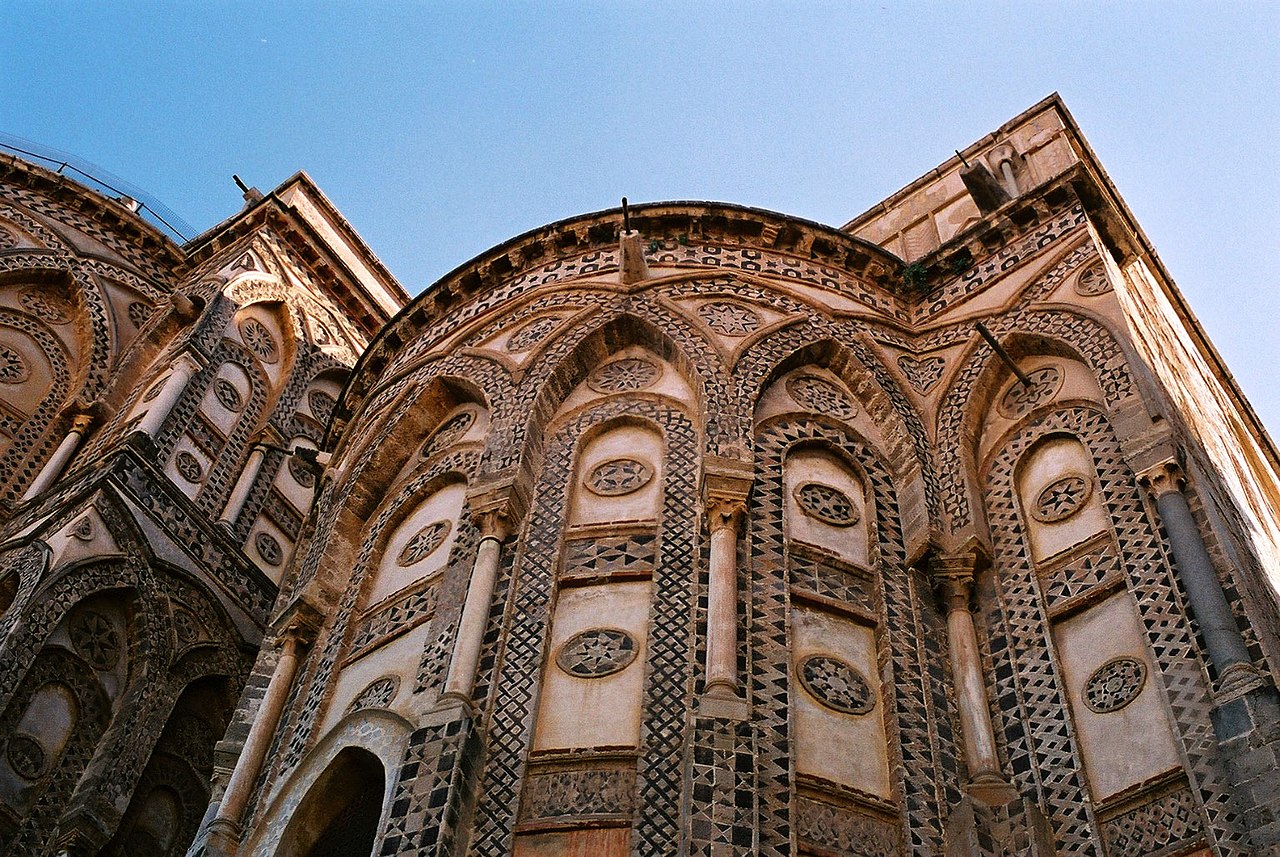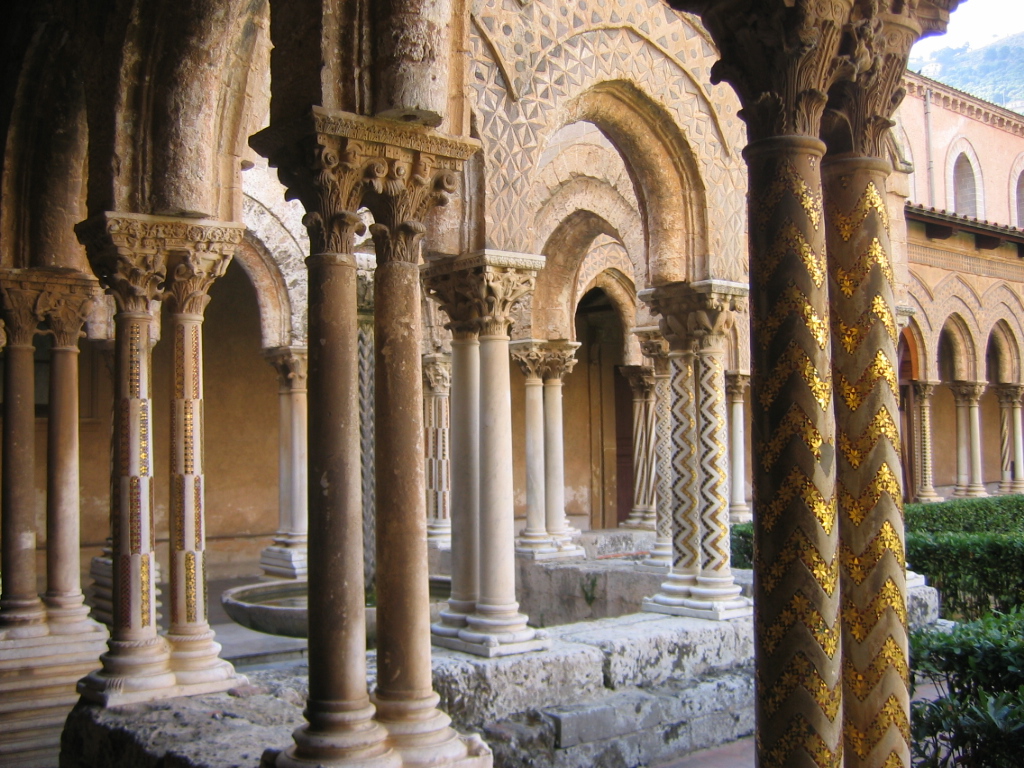This Article can be read in full at THE SPECTATOR

English: Santa Maria Nuova Cathedral, Monreale, Sicily.
Deutsch: Kathedrale Santa Maria Nuova, Monreale, Sizilien.
Photo: 8 September 2012.
Source: Own work.
Author: Pjt56.
(Wikimedia Commons)
"Discover the remarkable story of Sicily."
Available on YouTube at

Detail of mosaic depicting the Martyrdom of Saints Castus and Cassius.
12th-Century, at the Cathedral of Monreale, Sicily.
Illustration: THE SPECTATOR
Article by: Martin Gayford.
A few weeks ago, I looked out on the Cathedral of Monreale from the platform on which once stood the Throne of William II, King of Sicily. From there, nearly two acres of richly-coloured mosaics were visible, glittering with Gold. In the Apse, was the majestic figure of Christ Pantocrator — that is, "Almighty". The walls of the Aisles and Nave were lined with scenes from The Bible. In another Panel, just above, Christ Crowned King William.
It was a prospect of the greatest opulence and sophistication stretching in every direction from this Regal vantage point. The mosaics are in the manner of Byzantium, and probably executed by Greek artists, but the architectural Plan and Inlaid Floors are derived from Mediaeval Italy. This, then, Padre Nicola Gaglio, the Priest who was escorting us pointed out, was a building in which the Christian Traditions of East and West, Rome and Constantinople, were combined and contrasted.

English: Monreale Cathedral, Sicily, Italy.
Deutsch: Italien, Sizilien, Monreale, Kathedrale Santa Maria Nuova.
Photo: 9 October 2012.
Source: Own work.
Author: Berthold Werner.
(Wikimedia Commons)
The Island was also Quadrilingual, as an Inscribed Stone from 12th-Century Palermo demonstrates. This Inscription recorded the transfer of the remains of one Anna, mother of a Priest called Grisandus, to a Private Chapel. It does so, however, in Latin, Greek, Arabic and Judaeo-Arabic (an Arabic dialect written in Hebrew characters for an Arabic-speaking Jewish population). Each Text is slightly different, since — for example — the Stone is dated 1149, according to Western Christian chronology, 6657 according to The Byzantines, who began at The Creation of The World, and 544 by Islamic reckoning.
Norman Sicily even had an English connection. At Monreale, on the wall beneath the colossal figure of Christ — his Right Hand, alone, according to John Julius Norwich, is six feet high — is the unexpected figure of Saint Thomas Becket of Canterbury. Perhaps Becket’s image was put there among other Sainted Bishops in an apologetic spirit, since Saint Thomas had been hacked to death at the instigation of King William II’s father-in-law, King Henry II of England. Becket’s murder took place in 1170, or, at most, two decades before the mosaics were created.

Cathedral of Monreale, Sicily, Italy.
Arabesque ornaments at the Rear Apses.
The outsides of the principal doorways and their Pointed Arches are magnificently
enriched with carving and coloured inlay, a curious combination of three styles -
Norman-French, Byzantine and Arab.
Photo: 22 January 2006.
Source: Own work.
Author: Bjs.
(Wikimedia Commons)
The first Norman incursion into Sicily was in 1061, though the process of subduing the entire territory took decades. Before the Norse buccaneers arrived, Sicily had been under Islamic Rule for more than a Century; most of the population at that point was probably Muslim. Until the Islamic Invasion, the Island had been part of The Byzantine Empire and culturally Greek.

The Cloisters at Monreale Abbey, Sicily, Italy.
Date: 27 August 2005.
This File: 27 August 2005.
User: Urban~commonswiki.
(Wikimedia Commons)
By the time his Chapel was inaugurated in 1143, King Roger II controlled Sicily, most of Italy, South of Rome, and large areas of North Africa. In some respects, he and his successors followed the ways of The Middle East. They maintained harems and built superb Pleasure Palaces around Palermo, enthusiastically compared by Ibn Jubayr, a poet and traveller from Andalusia, to ‘necklaces strung around the throats of voluptuous girls’. Some of these, including those known as La Cuba and La Zisa — from al-Aziz (‘the Magnificent’) — closely resemble similar structures in 12th-Century Algeria and Egypt.

English: Cathedral of Monreale, Sicily, Italy.
Mosaics of the South Side of the Nave.
Français: Cathédrale de Monreale, Sicile, Italie.
Mosaïques du côté sud de la nef.
Photo: 9 October 2010.
Source: Own work.
Author: Tango7174.
(Wikimedia Commons)
The Norman Kings of Sicily were among the greatest Rulers of their day. Roger II clearly thought himself the equal of The Emperor in Constantinople. Under his reign, Sicily, making full use of its pivotal position in the centre of The Mediterranean, was powerful and prosperous as it had seldom been before — and never has been since. His hybrid Greek-Latin-Islamic State was hugely successful. Islamic bureaucrats kept records in flowing Arabic, the Bishops were Italian, French and English, and the Syrian Christian Arabic and Greek-speaking George of Antioch functioned as ammiratus ammiratorum, Emir of Emirs, or Commander-in-Chief.

King William II of Sicily offering
Monreale Cathedral to The Virgin Mary.
Photo: 26 January 2015.
Source: Own work.
Author: José Luiz.
(Wikimedia Commons)
‘When the power of the King fell away,’ Dirk Booms concluded, ‘it was clear that there were underlying tensions.’ After King William II died without an heir in 1189, Norman Sicily, after lasting for a glorious Century or so, quickly fragmented. Perhaps its lesson is that a multicultural society can be remarkably successful economically and culturally, but, without true integration, it is vulnerably fragile.
"Sicily: Culture and Conquest" is at The British Museum, Great Russell Street,
London WC1B 3DG, from 21 April to 14 August. Opening Times are 1000 hrs -1730 hrs, daily, except Friday which closes at 2030 hrs.

No comments:
Post a Comment